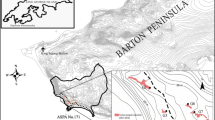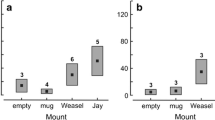Abstract
Anti-predatory behaviour is widespread among a broad range of animal taxa, including birds. Nest defence is not without risk, however, and parent birds face a trade-off between the survival of their offspring and the risk of injury or mortality to themselves. This study focused on the anti-predator behaviour of the Sabine’s gull (Xema sabini), a ground-nesting, Arctic breeder. Specifically, we quantified the gulls’ behavioural response towards natural predators, a human intruder, experimental predator decoys, and a non-predatory decoy. Neither the distance at which nesting Sabine’s gulls first reacted to natural predators, nor the relative intensity of their response, differed with incubation stage or predator type. However, response behaviour was highly variable among pairs. In response to decoys, Sabine’s gulls responded strongly towards predatory species, compared with a non-predatory species. The distance at which they first swooped at a human intruder was also variable, and there was no seasonal trend. Sabine’s gulls were often joined in nest defence by conspecifics, Arctic terns, and shorebirds nesting nearby, although the number of conspecifics involved in attacks was not related to the proximity of neighbouring nests.
Similar content being viewed by others
References
Abraham K, Ankney CD (1986) Summer birds of East Bay, Southampton Island, Northwest Territories. Can Field Nat 100:180–185
Andersson M, Wiklund CG, Rundgren H (1980) Parental defense of offspring: a model and an example. Anim Behav 28:536–542
Barash DP (1975) Evolutionary aspects of parental behavior: distraction behavior of the alpine accentor. Wilson Bull 87:367–373
Bêty J, Gauthier G, Korpimäki E, Giroux JF (2002) Shared predators and indirect trophic interactions: lemming cycles and arctic-nesting geese. J Anim Ecol 71:88–98
Biermann G, Robertson RJ (1981) Residential reproductive value and parental investment. Anim Behav 31:311–312
Brown RGB, Blurton-Jones NG, Hussel DJT (1967) The breeding behaviour of Sabine’s gulls (Xema sabini). Behaviour 28:110–140
Brunton DH (1990) The effect of nesting stage, sex, and type of predator on parental defense by killdeer (Charadrius vociferous): testing models of avian defense. Behav Ecol Sociobiol 26:181–190
Clark AB, Wilson DS (1981) Avian breeding adaptations: hatching asynchrony, brood reduction, and nest failure. Q Rev Biol 56:253–277
Clutton-Brock TH (1991) The evolution of parental care. Princeton University Press, Princeton
Curio E (1975) The functional organization of antipredator behaviour in the pied flycatcher: a study of avian visual perception. Anim Behav 23:1–115
Curio E (1976) The ethology of predation. Springer, Berlin Heidelberg New York
Curio E, Ernst V, Vieth W (1978) The adaptive significance of avian mobbing III. Z Tierpsychol 48:184–202
Day RH, Stenhouse IJ, Gilchrist HG (2001) Sabine’s gull (Xema sabini). In: Poole A, Gill F (eds) The birds of North America, vol 593. The Birds of North America, Philadelphia
Galeotti P, Tavecchia G, Bonetti A (2000) Parental defence in long-eared owls (Asio otus): effects of breeding stage, parent sex and human persecution. J Avian Biol 31:431–440
Gochfeld M (1984) Antipredator behavior: aggressive and distraction displays of shorebirds. In: Burger J, Olla BL (eds) Shorebirds: breeding behavior and populations. Plenum, New York, pp 289–377
Knight RL, Grout DJ, Temple SA (1987) Nest-defense behavior of the American crow in urban and rural areas. Condor 89:175–177
Krebs JR (1973) Behavioral aspects of predation. In: Bateson PPG, Klopfer PH (eds) Perspectives in ethology. Plenum, New York, pp 73–112
Kruuk H (1964) Predators and anti-predator behavior of the black-headed gull (Larus ridibundus L.). Behaviour 11(Suppl):1–129
Lack D (1954) The natural regulation of animal numbers. Oxford University Press, Oxford
Mallory ML, McNicol DK, Walton RA, Wayland M (1998) Risk-taking by incubating common goldeneyes and hooded mergansers. Condor 100:694–701
Martin TE (1995) Avian life-history evolution in relation to nest sites, nest predation, and food. Ecol Monogr 65:101–127
Montgomerie RD, Weatherhead PJ (1988) Risks and rewards of nest defence by parent birds. Q Rev Biol 63:167–187
Myers JP (1978) One deleterious effect of mobbing in the southern lapwing (Vanellus chilensis). Auk 95:419–420
Parmelee DF, Stephens HA, Schmidt RH (1967) Birds of southeastern Victoria Island and adjacent small islands. Natl Mus Can Bull 222:1–229
Patterson TL, Petrinovich L, James DK (1980) Reproductive value and appropriateness of response to predators by white-crowned Sparrows. Behav Ecol Sociobiol 7:227–231
Redondo T (1989) Avian nest defence: theoretical models and evidence. Behaviour 111:161–195
Redondo T, Carranza J (1989) Offspring reproductive value and nest defense in the magpie (Pica pica). Behav Ecol Sociobiol 25:369–378
Shields WM (1984) Barn swallow mobbing: self-defence, collateral kin defence, group defence or parental care? Anim Behav 32:132–148
Smith PA (2003) Factors affecting nest site selection and reproductive success of tundra nesting shorebirds. MSc Thesis, University of British Columbia, Victoria
Spaans B, Blijleven HJ, Popov IU, Rykhlikova ME, Ebbinge BS (1998) Dark-bellied brent geese (Branta bernicla) forego breeding when Arctic foxes (Alopex lagopus) are present during nest initiation. Ardea 86:11–20
Stenhouse IJ (2003) The reproductive behaviour and ecology of Sabine’s gulls (Xema sabini) in the eastern Canadian Arctic. PhD Thesis, Memorial University of Newfoundland, St. John’s
Stenhouse IJ, Gilchrist HG, Montevecchi WA (2001) Reproductive biology of Sabine’s gull in the eastern Canadian Arctic. Condor 103:98–107
Stenhouse IJ, Gilchrist HG, Montevecchi WA (2004) Reproductive investment and parental roles in Sabine’s gulls (Xema sabini). J Ethol 22:85–89
Walters JR (1982) Parental behavior in lapwings (Charadriidae) and its relationship with clutch sizes and mating systems. Evolution 36:1030–1040
Weatherhead PJ (1979) Do savannah sparrows commit the Concorde fallacy? Behav Ecol Sociobiol 5:373–381
Acknowledgements
We are grateful to the community of Coral Harbour for permission to work in East Bay, Southampton Island, Nunavut. We are deeply indebted to Rachel Bryant for her dedication and assistance in the field, and to all members of the East Bay field crews for their assistance, encouragement and companionship over the years of this study. We thank Greg Robertson for statistical advice, and two anonymous referees for their insightful comments on an earlier draft. Research was supported by the Northern Conservation Division of the Canadian Wildlife Service (HGG), NSERC (via a Discovery Grant to WAM), Memorial University of Newfoundland (via a graduate fellowship and the Hatcher Scholarship to IJS), and The Seabird Group (via a research grant to IJS).
Author information
Authors and Affiliations
Corresponding author
About this article
Cite this article
Stenhouse, I.J., Gilchrist, H.G. & Montevecchi, W.A. An experimental study examining the anti-predator behaviour of Sabine’s gulls (Xema sabini) during breeding. J Ethol 23, 103–108 (2005). https://doi.org/10.1007/s10164-004-0135-1
Received:
Accepted:
Published:
Issue Date:
DOI: https://doi.org/10.1007/s10164-004-0135-1




